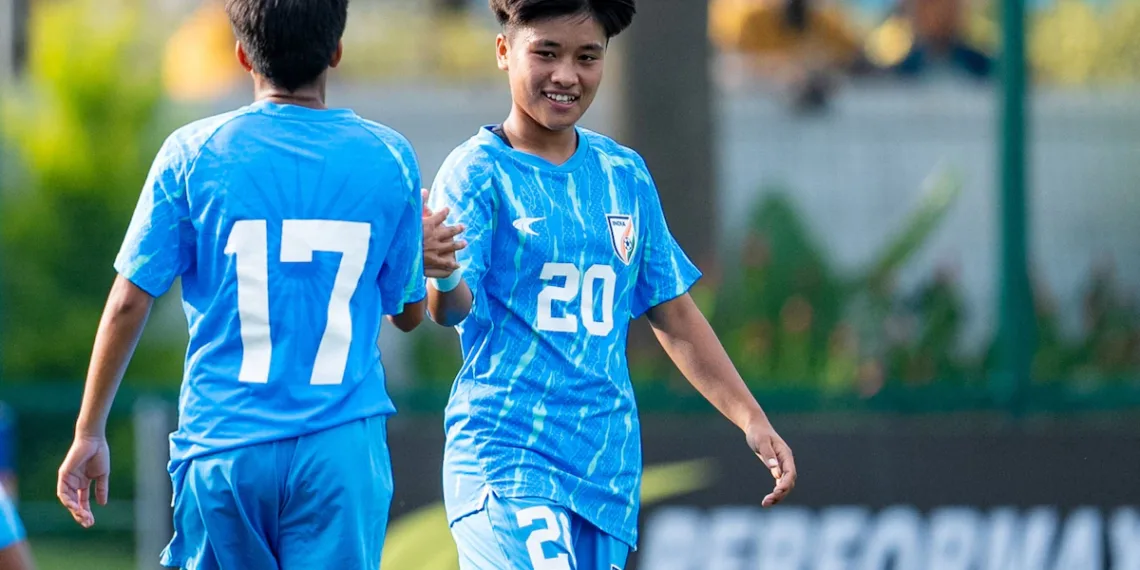The stage is set for an exciting chapter in Indian women’s football as the Blue Tigresses prepare to face familiar rivals and emerging challengers on their continental journey.
Table of Contents
India Drawn Into Competitive Group B

The anticipation has finally ended for football fans across Asia as the AFC Women’s Asian Cup 2026 Qualifiers draw was officially announced yesterday. India’s women’s national team, affectionately known as the Blue Tigresses, has been placed in Group B alongside host nation Thailand, Mongolia, Timor-Leste, and Iraq.
This grouping sets the stage for what promises to be a fascinating qualification campaign, with matches scheduled to take place between June 23 and July 5, 2025, in a centralized format hosted by Thailand. For Indian football supporters, the draw brings both opportunity and challenge as the team begins its journey toward continental glory and potential World Cup qualification.
“Being drawn with Thailand is particularly interesting given our historical rivalry,” noted a spokesperson for the Indian team. “Playing on their home soil adds an extra dimension to what was already going to be a competitive group.”
Asia Women’s Football Landscape: Understanding the Qualification Format
The AFC Women’s Asian Cup 2026 qualifiers feature a total of 34 teams divided across eight groups – six groups containing four teams each and two groups with five teams. India finds itself in one of the larger five-team groups, meaning they’ll play a total of four matches in the single round-robin format.
What makes these qualifiers particularly crucial is the qualification method – only the group winners will advance to the finals tournament. There’s no room for error or second chances, raising the stakes for every single match in the qualification campaign.
The finals tournament, set to be hosted by Australia across venues in Sydney, Perth, and Gold Coast in March 2026, will feature 12 teams in total. Three teams have already pre-qualified: Australia as hosts, China as defending champions, and Japan as the previous edition’s runners-up.
For the remaining nine spots, the competition will be fierce among Asia women’s football teams, with each nation desperate to secure their place on the continental stage.
AFC Women’s Asian Cup Qualifiers: Breaking Down Group B Teams
Let’s take a closer look at the teams India will face in Group B:
Thailand (Host): The historical significance of this matchup cannot be overstated. Thailand defeated India in the 1983 Asian Cup final, a memory that still resonates with long-time followers of women’s football in the region. As hosts of Group B, Thailand will enjoy home advantage and the support of their passionate fans.
Mongolia: A team still developing their women’s football program, Mongolia represents the growing reach of the women’s game across Asia. While they have limited participation in previous Asian Cup tournaments, they should not be underestimated as they look to make their mark.
Timor-Leste: Another emerging team in the women’s football landscape, Timor-Leste brings youthful energy and determination to the group. Their participation highlights the expanding footprint of women’s football across Southeast Asia.
Iraq: With a growing women’s program, Iraq completes this diverse group of teams. They’ll be looking to use this tournament as a platform to accelerate the development of their women’s football infrastructure and talent pipeline.
The India women’s football team enters these qualifiers with a rich history in the competition, having been runners-up twice (1980 and 1983) and securing third place in 1981. With nine previous Asian Cup appearances, they bring valuable tournament experience to the group.
Womens World Cup 2027: How the Asian Cup Shapes Qualification Chances

The stakes extend beyond just the AFC Women’s Asian Cup 2026. This tournament serves as a crucial qualification pathway to the Womens World Cup 2027, set to be held in Brazil. The top six teams from the Asian Cup will earn direct qualification to the global showcase, making success in these qualifiers the first step toward the world stage.
“Every player dreams of representing their country at a World Cup,” said one of India’s veteran players. “We know that journey begins here, with these qualifiers. One match at a time, that’s our focus.”
For many of the players competing in Group B, the 2027 Women’s World Cup represents the ultimate dream beyond Asian success. The qualification process begins with these crucial Asian Cup matches, highlighting the interconnected nature of international women’s football competitions.
India Women’s Football Team: Historical Performance and Current Form
The Blue Tigresses enter the qualifiers with renewed confidence after showing promising signs in recent tournaments. India’s women’s football has experienced a resurgence since 2010, with increased investment and support helping to develop a new generation of talented players.
Fans are eagerly awaiting to see the India women’s football team compete against regional rivals, particularly Thailand. The historical rivalry between these two nations adds extra spice to what was already going to be a competitive group.
Thailand Women’s Football: The Host Nation’s Advantages in Group B
Hosting the group gives Thailand women’s football a significant home advantage. The familiar conditions, supportive crowd, and reduced travel fatigue could all play in their favor as they look to secure the sole qualification spot from Group B.
Recent investments in Thailand women’s football have strengthened their competitive position in the Asian football hierarchy. Their historical success against India, including that famous 1983 Asian Cup final victory, will give them psychological confidence heading into this crucial qualifier.
2027 Women’s World Cup Dreams: What Group B Victory Means for India
The pathway to the 2027 Women’s World Cup runs directly through the Asian Cup tournament. For India, topping Group B would represent more than just qualification for the AFC Women’s Asian Cup 2026 – it would put them one step closer to returning to the global stage.
Teams competing in Group B all have their sights set on the 2027 Women’s World Cup in Brazil, understanding that continental success is the gateway to global competition. The dream of representing Asia on the world stage serves as powerful motivation for all teams involved.
Blue Tigresses’ Path to Glory: Key Matches and Challenges Ahead

The road to AFC Women’s Asian Cup 2026 begins with these crucial qualifier matches. For the Blue Tigresses, the match against Thailand likely represents the most significant challenge, given both the host nation advantage and the historical rivalry between the teams.
However, underestimating any opponent could prove costly in a format where only the group winner advances. Each match must be approached with the same level of preparation and determination if India hopes to secure their place in Australia for the finals tournament.
As the qualification tournament approaches in June 2025, excitement continues to build among supporters of women’s football across Asia. For India, the journey to continental glory – and potentially World Cup qualification – now has a clear path forward through Group B.
The question remains: can the Blue Tigresses navigate this challenging group and take their place among Asia’s elite at the AFC Women’s Asian Cup 2026 in Australia? Football fans across India will be watching with anticipation as their team embarks on this crucial qualification campaign.
FAQ:-
What is the Asia Cup qualifier?
Why does Australia play in the AFC Asian Cup?
Australia were part of the Oceania Football Confederation but were constantly left frustrated because they failed to qualify for the FIFA World Cup due to their ranking in the OFC.








